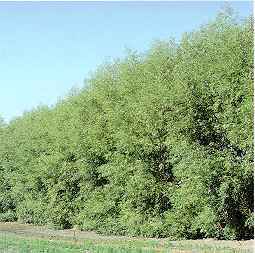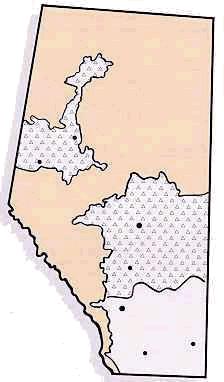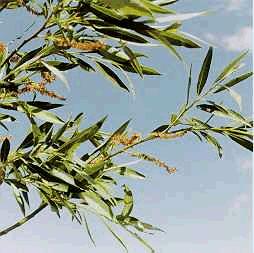| |
Shelterbelt Varieties for Alberta - Acute Leaf Willow | |
| |
|
|
| |
|
|
| | Plant characteristics | Fall colour | Site preference | Hardiness | Uses | Problems | Diseases | Insects | Pruning
.

Scientific Name: Salix acutifolia wild
Plant Characteristics
Acute leaf willow is a fast-growing shrub or tree with a large number of wide spreading stems. It can reach a mature height of 8 to 15 m (26 to 50 ft) and a spread of 9 m (30 ft). Its annual growth rate varies from 50 to 200 cm (1.5 to 6 ft) and it has a useful lifespan of 25 to 60 years.
Branches are slender, violet or red-brown, bloomy. They can be used for coarse basket work.
Buds - Older stems develop a deep furrowed bark.
Leaves - The leaves are alternate, simple, lanceolate to linear-lanceolate; long-acuminate, cuneate. It has shiny leaves 6 to 12 cm (2.5 to 5 in.) long and 1 to 2 cm (0.25 to 1 in.) wide with a dark green upper surface and duller green lower surface. The margins are finely-toothed and extend to a pointed tip.
Propagated by cuttings.
Fall Colour
Green leaves remain late into fall.
Site Preference
Acute leaf willow can be planted in full sun or half shade. It likes moisture, but not poorly drained soil. It can tolerate short periods of flooding. It prefers organic soil and will not tolerate alkaline soil.
Hardiness
Hardy - will survive under extreme climatic conditions, but liable to tip kill when young.
.


Uses
Acute leaf willow is planted as screening, shelterbelt and single-stemmed specimen in a landscape situation.
In shelterbelt situations this willow should be planted 2 to 4 m (6 to 13 ft) between trees in the rows and 5 to 8 m (17 to 26 ft) between rows.
Problems
Performs poorly in arid sites.
Diseases
Moderately disease free.
Insects
The leaves of this willow are often infested with reddish galls caused by the larvae of the redgall sawfly.
Pruning
When the tree is young, it can be pruned to a single straight trunk, but also grows as multi-stemmed especially in shelterbelts.

Shelterbelts Varieties for Alberta provides information on a number of other trees and shrubs than may be suitable for shelterbelts.
Visit our website directory for the Reforestation Woodlot Listings.
|
|
| |
|
|
| |
For more information about the content of this document, contact Toso Bozic.
This document is maintained by Brenda McLellan.
This information published to the web on May 4, 2001.
Last Reviewed/Revised on December 18, 2017.
|
|